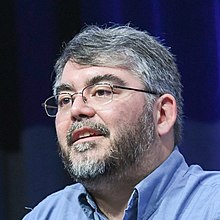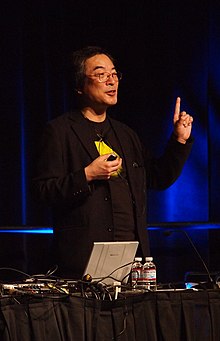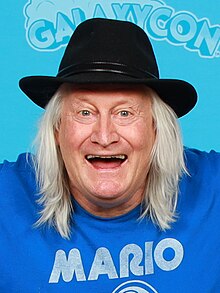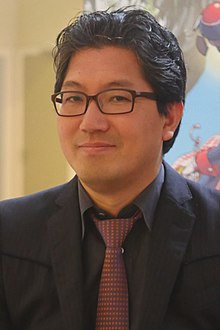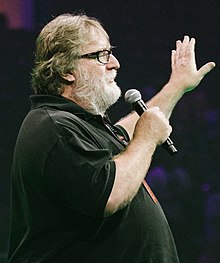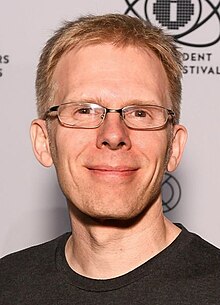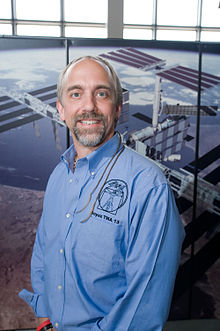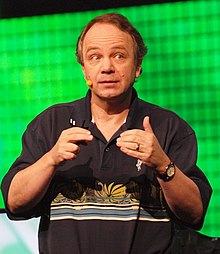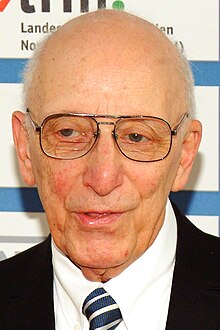Portal:Video games
The Video Games Portal

A video game or computer game is an electronic game that involves interaction with a user interface or input device (such as a joystick, controller, keyboard, or motion sensing device) to generate visual feedback from a display device, most commonly shown in a video format on a television set, computer monitor, flat-panel display or touchscreen on handheld devices, or a virtual reality headset. Most modern video games are audiovisual, with audio complement delivered through speakers or headphones, and sometimes also with other types of sensory feedback (e.g., haptic technology that provides tactile sensations). Some video games also allow microphone and webcam inputs for in-game chatting and livestreaming.
Video games are typically categorized according to their hardware platform, which traditionally includes arcade video games, console games, and computer (PC) games; the latter also encompasses LAN games, online games, and browser games. More recently, the video game industry has expanded onto mobile gaming through mobile devices (such as smartphones and tablet computers), virtual and augmented reality systems, and remote cloud gaming. Video games are also classified into a wide range of genres based on their style of gameplay and target audience. (Full article...)
Featured articles –
After releasing Halo 3 in 2007, Bungie split into teams to develop two different games—what would become Halo 3: ODST and Reach. The developers decided to create a prequel to the original Halo game trilogy, freeing themselves from the obligation of addressing old story threads. As the game would take place on a human world doomed to be destroyed, they focused on making the environment a character unto itself. Longtime Halo composers Martin O'Donnell and Michael Salvatori returned to compose Reach's music, aiming for a more somber sound to match the story.
Reach was announced at E3 2009 in Los Angeles, and the first in-engine trailer was shown at the 2009 Spike Video Game Awards. Players who purchased ODST were eligible to participate in a Reach multiplayer beta in May 2010; the beta allowed Bungie to gain player feedback for fixing bugs and making gameplay tweaks before shipping the final version. Microsoft gave Reach its biggest game marketing budget yet and created award-winning live-action commercials, action figures, and interactive media to promote the game. (Full article...)
New Super Mario Bros. released with critical and commercial success, with many considering it as the main contributor in the revival of the 2D platforming genre. Praise went towards the game's improvements and introductions made to the Mario franchise and faithfulness to older Mario games, while criticism was targeted at its low difficulty level and lingering similarities to previous games. It was called one of the best games available for the Nintendo DS by several critics with some further calling it one of the best side-scrolling Super Mario titles. It sold over 30 million copies worldwide, making it the best-selling game for the Nintendo DS and one of the best-selling video games of all time. The game's success led to a line of sequels released for the Wii, Nintendo 3DS, Wii U, and Nintendo Switch. (Full article...)
Designer Andrew Shouldice developed Tunic, his first major game, over seven years. He began work on it as a solo project in 2015, wanting to combine challenging gameplay with gentle visual and audio design. He was inspired by his childhood experiences playing Nintendo Entertainment System games like The Legend of Zelda (1986) and trying to understand game manuals for which he lacked context. Shouldice was joined during development by composers Terence Lee and Janice Kwan, audio designer Kevin Regamey, developer Eric Billingsley, and producer Felix Kramer. Publisher Finji joined the project in 2017 and announced Tunic at E3 2017.
Tunic was released for macOS, Windows, Xbox One, and Xbox Series X/S in March 2022, followed by ports for Nintendo Switch, PlayStation 4, and PlayStation 5 in September. It received positive reviews, especially for its aesthetics, design, and gameplay, but drew some criticism for uneven difficulty and potential for players to feel stuck. Tunic won the Outstanding Achievement for an Independent Game award at the 26th Annual D.I.C.E. Awards, and the Artistic Achievement and Debut Game awards at the 19th British Academy Games Awards. (Full article...)
The game was designed as a testbed for the PlayStation Vita. During development, Studio Liverpool staff sent feedback about aspects that could affect the Vita design to Sony. Some of their suggestions, including the addition of a rear touchscreen and two separate joysticks, were added to the Vita.
Wipeout 2048 preserves some technical aspects of its predecessor game Wipeout HD, including downloadable content (DLC), online multiplayer mode, and cross-platform play with PlayStation 3 owners running Wipeout HD. It received mainly positive reviews; critics said its graphics and visuals showcased the power of the then-new PlayStation Vita but criticised its long loading times and other technical problems. The game, together with Wipeout HD and its Fury expansion, was remastered for PlayStation 4 and released as Wipeout Omega Collection in 2017. (Full article...)
OneShot's gameplay and plot break the fourth wall and involve metafictional elements. Many puzzles involve interacting with the computer's operating system outside of the game. Narratively, the player is separate from the protagonist, Niko. The latter arrives in a world without sunlight and aims to restore it by replacing its sun, a lightbulb, at the top of a tower.
OneShot was developed in RPG Maker XP. The game received positive reviews from critics, who praised the story, art, and metafictional aspects of gameplay, including the relationship between the player and Niko. In 2017, the game was nominated for the "PC Game of the Year" category at the Golden Joystick Awards. (Full article...)
The story follows bounty hunter Samus Aran after she is sent to rescue Galactic Federation Marines from a ship near Aether, a planet inhabited by a race known as the Luminoth. She discovers that the troops were slaughtered by the Ing, a hostile race that came from an alternate dimension of Aether. Samus must travel to four temples to ensure the destruction of the evil Ing, while battling them, wild creatures, Space Pirates, and her mysterious doppelgänger Dark Samus.
Retro sought to differentiate Echoes with a heavier focus on storytelling and new gameplay mechanics. Nintendo launched a viral marketing campaign that included several websites written as if taking place in the Metroid universe. The single-player mode was acclaimed for its graphics, atmosphere and music, though its steep difficulty and multiplayer mode were met less positively. (Full article...)
Designed by an R&D team supervised by Hideki Sato and Masami Ishikawa, the Genesis was adapted from Sega's System 16 arcade board, centered on a Motorola 68000 processor as the CPU, a Zilog Z80 as a sound controller, and a video system supporting hardware sprites, tiles, and scrolling. It plays a library of more than 900 games on ROM-based cartridges. Several add-ons were released, including a Power Base Converter to play Master System games. It was released in several different versions, some created by third parties. Sega created two network services to support the Genesis: Sega Meganet and Sega Channel.
In Japan, the Mega Drive fared poorly against its two main competitors, Nintendo's Super Famicom and NEC's PC Engine, but it achieved considerable success in North America, Brazil, and Europe. Contributing to its success was its library of arcade game ports, the popularity of Sega's Sonic the Hedgehog series, several popular sports franchises, and aggressive youth marketing that positioned it as the cool console for adolescents. The 1991 North American release of the Super Nintendo Entertainment System triggered a fierce battle for market share in the United States and Europe known as the "console war". This drew attention to the video game industry, and the Genesis and several of its games attracted legal scrutiny on matters involving reverse engineering and video game violence. Controversy surrounding violent games such as Night Trap and Mortal Kombat led Sega to create the Videogame Rating Council, a predecessor to the Entertainment Software Rating Board. (Full article...)
The game was developed rather quickly as a sequel to the Nintendo 64 title Hey You, Pikachu! and to promote the Nintendo e-Reader accessory, and uses a novel 3D texturing effect. It was first showcased at Electronic Entertainment Expo (E3) 2003 and later through a month-long series of promotional events in Sapporo, Hokkaido, Japan. It was released on July 18, 2003, in Japan, December 1 in North America, and April 2, 2004, in Europe. In Japan, the game sold 66,373 copies in its first year. It received mixed reviews, which generally criticized its low level of interactivity and repetitive sound effects, though its collecting aspects and visuals were somewhat better received. (Full article...)
After Sonic the Hedgehog greatly increased the popularity of the Genesis in North America, Sega directed STI founder Mark Cerny to start Sonic 2 in November 1991. Members of the original development team—including programmer Yuji Naka and designer Hirokazu Yasuhara—moved from Japan to California to join the project. Sonic 2 was intended to be faster and more ambitious than the first game. The development suffered setbacks, including cultural differences between the Japanese and American staff, and numerous levels were cut due to time constraints and quality concerns. As with the first game, Masato Nakamura, a member of the J-pop band Dreams Come True, composed the soundtrack.
Sonic 2 was widely anticipated, and Sega backed it with an aggressive $10 million marketing campaign. It was released in November 1992 to acclaim and received numerous year-end accolades, including two Golden Joystick Awards. Critics considered Sonic 2 an improvement over the first game and praised the visuals, level design, gameplay, and music, though the low difficulty level and similarities to its predecessor were criticized. Sonic 2 grossed over $450 million and sold six million copies by 2006, making it the second-bestselling Genesis game behind the original Sonic the Hedgehog. (Full article...)
Did you know... -
- ... that the game designer of the video game Hades said that the characters were attractive "because Jen Zee"?
- ... that after becoming paralyzed from the neck down, Rocky "RockyNoHands" Stoutenburgh broke two Guinness World Records in the video game Fortnite?
- ... that the video game Pyongyang Racer was developed in North Korea for Koryo Tours, which organises tours to the country?
- ... that the video game Manor Lords was wishlisted more than three million times on Steam after its developer had estimated it would receive around 14,000?
- ... that 1980's Space Encounters video game was the first that Midway Games offered in their "mini myte" arcade game cabinet?
- ... that classified documents of the United States were partially leaked onto a Discord server for the video game Minecraft?
- ... that MicroProse was formed to publish Hellcat Ace after Sid Meier boasted that he could design a better video game than Red Baron in a week?
- ... that the 1979 video game Superman was one of the first console games with a pause feature?
- ... that Through the Darkest of Times was the first video game published in Germany to use swastikas?
- ... that the album series Jingle Cats spawned Jingle Dogs, Jingle Babies, and a Japanese video game in which "the object is to breed and care for cats, which begin to sing when they're done copulating"?
- ... that the developer of The Stillness of the Wind was inspired to make the video game after fantasizing with his girlfriend about raising goats instead of living in London?
- ... that the name of the video game mod series Bomba Patch was inspired by éclairs?
Selected biography –
Selected image -
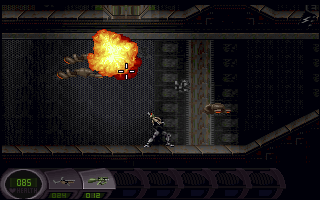
- April 16, 2024 – 2023–2024 video game industry layoffs
- American video game company Take-Two Interactive lays off 5% of its workforce. (Reuters)
- April 10, 2024 – 2023–2024 video game industry layoffs
- American video game company Epic Games announces that it will lay-off around 870 employees, roughly one-sixth of its workforce, due to slower growth than expected. (CBC via Yahoo! News)
- December 22, 2023 –
- China passes a series of regulations aimed at limiting video game microtransactions. The new rules include banning rewards for logging on for multiple consecutive days and banning rewards for players if they spend money in a game for the first time. (Reuters)
Topics
Categories
Things you can do
In other Wikimedia projects
The following Wikimedia Foundation sister projects provide more on this subject:
-
Commons
Free media repository -
Wikibooks
Free textbooks and manuals -
Wikidata
Free knowledge base -
Wikinews
Free-content news -
Wikiquote
Collection of quotations -
Wikisource
Free-content library -
Wikiversity
Free learning tools -
Wiktionary
Dictionary and thesaurus


